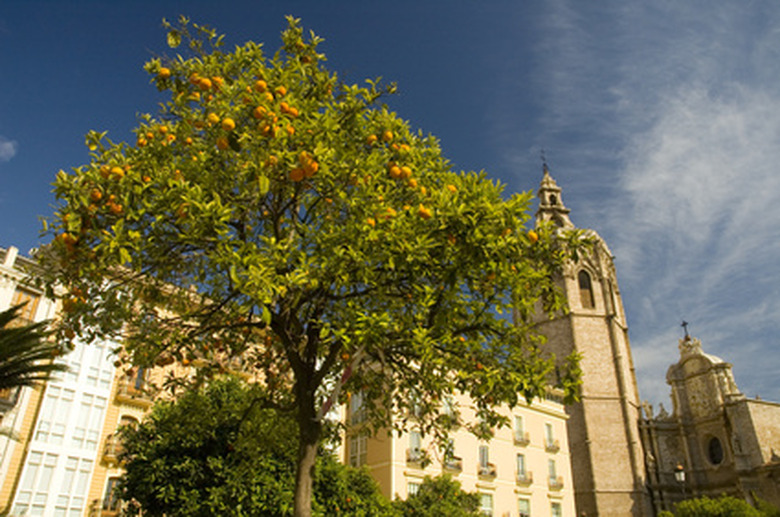How To Identify Citrus Fruit Trees
Citrus trees can grow all over the world. This subtropical evergreen family can be planted for culinary, medicinal or aesthetic purposes. Even though each variety may be easy to identify with fruit hanging on the branches during growing season, it is beneficial to identify them throughout the rest of the year by their size, foliage or shape. The most common citrus trees are oranges, lemons, limes, grapefruits and mandarins, and keep in mind that they cannot survive in temperatures that drop below 20 degrees F if they are outdoors.
Step 1
Look for any fruiting that is occurring on the trees, because this is the easiest way to recognize citrus trees. Examine the color and shape. Grapefruits grow the largest usually, from pale yellow to pinkish orange that are round, heavy and average about 4 to 5 inches in diameter. Oranges and lemons both grow about 2 to 4 inches in diameter with bumpy thick rinds, but lemons grow bright yellow and oranges grow bright orange to yellowish-orange. Bright green to greenish yellow limes are much smaller than the other citrus, around 1 to 2 inches in diameter.
- Citrus trees can grow all over the world.
- The most common citrus trees are oranges, lemons, limes, grapefruits and mandarins, and keep in mind that they cannot survive in temperatures that drop below 20 degrees F if they are outdoors.
Step 2
Consider the size of the citrus tree, since all varieties grow different sizes and shapes. The tallest citrus trees are orange and grapefruit, each growing from 15 to 30 feet tall. Both these varieties have rounder shapes. Lemon and lime trees range from 10 to 15 feet tall and do not look round, but more shrublike and with spikier branches. (They both have small, thorny branches and offshoots.)
Mandarin trees are the smallest size, averaging around 10 to 15 feet. They are more slender then other citrus trees.
- Consider the size of the citrus tree, since all varieties grow different sizes and shapes.
- The tallest citrus trees are orange and grapefruit, each growing from 15 to 30 feet tall.
Step 3
Examine any apparent flowers, since flowering occurs before fruiting. Almost all citrus trees have small white flowers with fragrant sweet aromas. Grapefruit is the exception, because these flowers don't have an aroma. Lime and lemon trees have white flowers with a purple underside. Sometimes when the flowers are very mature right before fruiting, they will have an aroma of the specific fruit, such as lemon, orange, lime or grapefruit.
Step 4
Notice the size and shape of the citrus tree leaves, because this can be an ideal way to identify citrus. Two- to 5-inch-long elliptical leaves that have dark green on the upper part of the leaf and a light green underside are present on lemon and lime trees, but lemons have leaves with serrated edges and growing in clusters, while limes have very glossy leaves that grow separately. Orange and tangerine leaves are both very shiny and dark green with a rounded base. Orange range from 3- to 5-inches-long and grow separately, though, while tangerines grow in clusters. Tangerine leaves range from 1- to 3-inches-long and grow in clumps. Grapefruit leaves have a round base and pointy tip and are very glossy, ranging from 3- to 5-inches-long.
- Examine any apparent flowers, since flowering occurs before fruiting.
- Two- to 5-inch-long elliptical leaves that have dark green on the upper part of the leaf and a light green underside are present on lemon and lime trees, but lemons have leaves with serrated edges and growing in clusters, while limes have very glossy leaves that grow separately.
